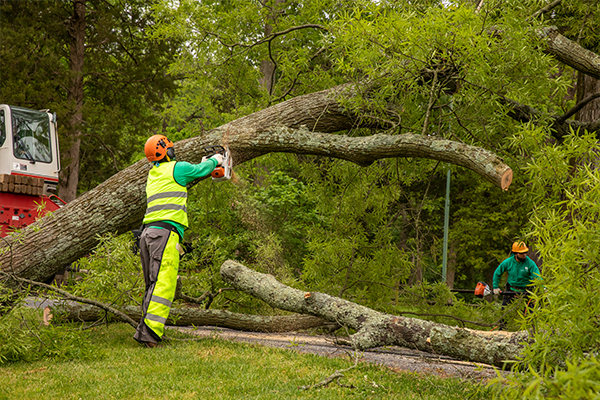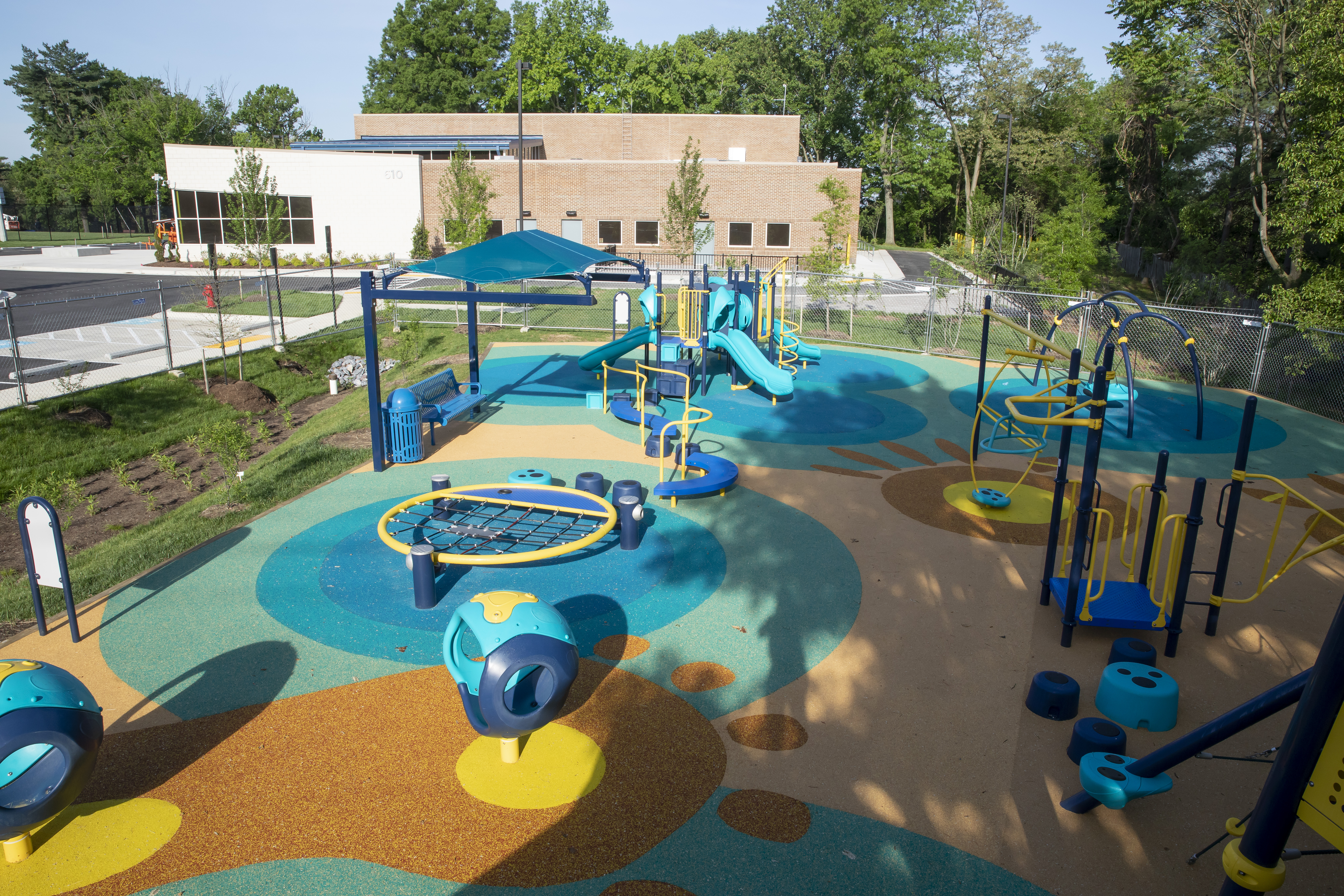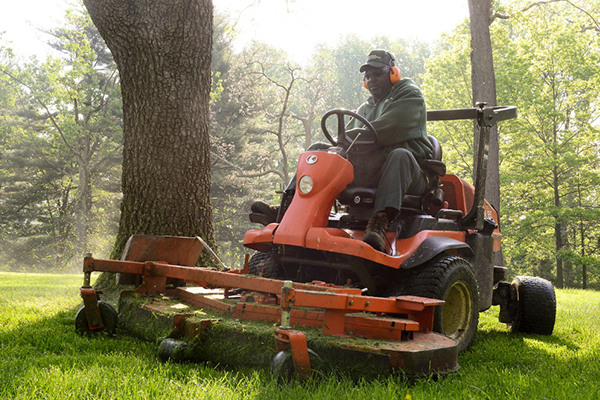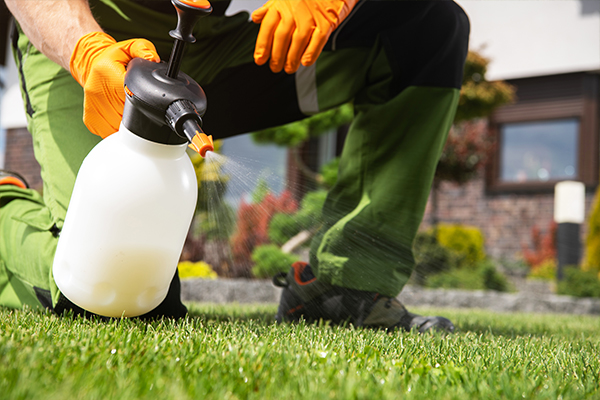Park & Facility Maintenance
In compliance with existing Maryland Regulations, it is the property owner’s responsibility to remove fallen trees and debris from private property.
The M-NCPPC, Department of Parks and Recreation Help Desk is a one-stop shop for reporting and checking the status of maintenance issues in the parks.
How do I report tree-related concerns on M-NCPPC parkland?
Call the M-NCPPC, Department of Parks and Recreation Customer Service Help Desk at 301-699-2255, or send an email to customerservice@pgparks.com for non-emergencies.
Who is responsible for removing the tree or limbs that have fallen onto my property?
Under Maryland Law, in the case of fallen trees or similar accidents that may be qualified as an “Act of God,” the affected owners are responsible for damages to their property, including cleanup, removal, and related expenses. These expenses may be covered under the homeowner’s insurance policy.
What is the status of my existing work request?
Call the M-NCPPC, Department of Parks and Recreation’s Customer Service Help Desk at 301-699-2255.
Why doesn’t M-NCPPC, Department of Parks and Recreation remove trees from private property?
The Arboriculture Section of M-NCPPC, Department of Parks and Recreation has a duty to mitigate known risks associated with trees located on park property, especially in and around amenities or areas where we invite the public. In compliance with existing Maryland state laws, it is the property owner’s responsibility to provide removal of trees and debris and to make repairs to private property.
What is the process after a work request is created?
Our Senior Arborist will inspect the request within three to five business days. After inspection, the work is prioritized and scheduled with respect to the tree crew’s work program.
How does the Senior Arborist prioritize work requests?
The M-NCPPC, Department of Parks and Recreation has an active policy to maintain the safety of parkland from potential damages and/or injury resulting from trees considered to be a “high risk” of failure. The Arboriculture Section strives to eliminate, in a timely fashion, any tree growing on parkland that is deemed to be at high risk of failure. Priority is placed on trees deemed to create unsafe situations. The determination of the risk of failure associated with any given tree is determined by the Senior Arborist with respect to their professional experience and the International Society of Arboriculture’s Tree Risk Assessment standards.
What determines the timeline for the completion of work?
There are over 500 parks in Prince George’s County which encompass over 29,000 acres of land. The Arboriculture Section consistently has numerous active work requests for tree work that have already been inspected, prioritized, and are waiting in queue to be completed by our staff of highly-trained tree professionals. Find the closest park in your area outfitted with different amenities.
Contact Us
Parks & Recreation Help Desk
Invasive Species
What Are Invasive Species?
An invasive species is a non-native plant, animal, or disease that harms the environment, economy, or human health. All invasive species are non-native, but not all non-native species are invasive. (See: Standardized IS Terminology). These species usually have fast growth and few natural pests or predators which allows them to rapidly reproduce and spread.

Why Care About Invasive Species?
Every day, our lives are impacted by invasive species. The Asian tiger mosquitoes that bite you and your loved ones during the day are invasive and transmit diseases. Our tree canopy is being threatened by invasive vines like English ivy that grow overtop the trees. Invasive bamboo can choke out native plants, animals, and their habitats. Invasive species also negatively affect agriculture and can make some of our park spaces unsafe.
What Can Be Done About Invasive Species?
There are different ways invasive species can be stopped from spreading into our landscapes. These include:
Prevention
Preventing invasive species from being established is one of the best ways to combat invasive species! Some prevention techniques include:
- Don’t Let it Loose– For the health of your pets and for the environment, do not release unwanted pets outside. Instead, investigate ways to rehome them.
- Plant Native Species– Many invasive plants in Maryland have been established from the garden trade. Consider helping local wildlife and the environment by planting species native to the area. Check out Maryland’s Best Native Plants Program for more information.
- Clean, Drain, and Dry– Stop the spread of accidental hitchhikers by cleaning your gear, boats, and other outdoor equipment. Many invasive plants can accidentally get ‘spread in the tread’ of your hiking boots. Consider using a boot brush to remove soil and debris after each hike and check out the Clean, Drain, Dry page for information on how to prevent hitchhikers on watercrafts.
- Education and Outreach– Teach friends, family, and neighbors about the threats of invasive species and how we each can play a part is a great way to prevent future invasive species. At the Department of Parks and Recreation (DPR), we have several invasive plant outreach programs and are always willing to provide expertise if needed.

Early Detection
If invasive species can be detected and removed early in the invasion process, we have a greater chance of successfully eradicating or controlling them. Here are some early detection techniques:
- Report suspected invasive plant sightings on iNaturalist– In coordination with the National Capital PRISM project, we are monitoring reports of early detection species as they come in. In some cases, these early alerts will allow us to act quickly before certain species become established.
- Coming Soon! Become an Invader Detector– Help report early detection species in Prince George’s County Parks as a volunteer Invader Detector. More details will be coming soon.
Control & Management
Once invasive species have become established, the next steps are to try to control and manage them. These techniques include:
- Manual Control – Control invasive plants by cutting, digging, and pulling them up. For some species of invasive plants like Japanese knotweed, this method can encourage spread, so manual control sometimes has to be paired with chemical control. Some of this work is accomplished by volunteers like the (Coming Soon!) Weed Warriors (link to new page), staff, and licensed contractors.
- Chemical Control – In conjunction with manual control, herbicides are occasionally needed to kill certain plant species. If chemical control is deemed to be necessary, then the best available science will be used to determine the correct amount, timing, and treatment plan. For many woody plant species, a cut stem approach will be employed where herbicides will be applied directly to a cut stem to reduce the footprint of the application.
- Biological Control – At this time, DPR will not be employing biological control agents like invertebrate predators unless under the direction of the Maryland Department of Agriculture.
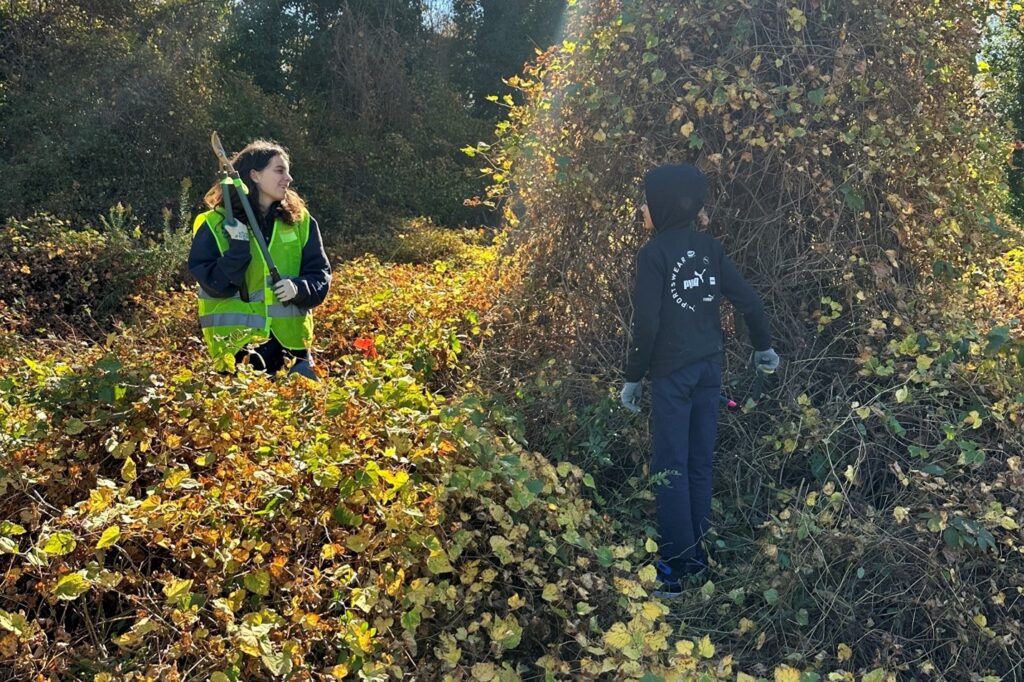
Upcoming Maintenance Projects
Bladensburg Waterfront Park
Contractors will begin vegetation management along portions of the boardwalk beginning August 2025.
Cottage City Park
In conjunction with the Chesapeake Climate Action Network and contractors, sections of the park adjacent to Bunker Hill Road and along the Anacostia River Trail will have invasive plants removed beginning August 2025 through August 2027.
Rhode Island Trolley Trail
At the end of July 2025, contractors will begin removing invasive vines and shrubs on the western edge of the property. This work will continue through August 2027.
What is the Department Doing to Manage Invasive Species?
With over 500 parcels and over 30,000 acres of land to manage, we have significant acreage to cover. At this time, our vegetation management program focuses on early detection species, conserving natural and cultural resource assets within the park system, and responding to community needs. We are working with partners to tackle invasive vines on our lands and will be deploying a volunteer Weed Warrior program to help as well. In some cases, we will be working with licensed contractors to do removals.
In compliance with existing Maryland Regulations, it is the property owner’s responsibility to remove fallen trees and debris from private property. The M-NCPPC, Department of Parks and Recreation Help Desk is a one-stop shop for reporting and checking the status of maintenance issues in the parks. www.pgparks.com
We are excited to announce the launch of the new Weed Warrior volunteer (link to new page) program which will train volunteers to assist with manual removal of invasive plants within our parks. Please click the link above to learn more.
Contact
If you are interested in being added to our email list for updates on our invasive species management program, including volunteer opportunities, please contact our Vegetation Ecologist, Kerry Wixted at Kerry.wixted@pgparks.com or fill out this interest form:
Lead Testing of Playground Surfaces
In 2019-2020, M-NCPPC Department of Parks and Recreation in Prince George’s County, conducted specialized testing to assess lead levels in rubberized play surfaces.
Fifty-four of the Department’s playgrounds contain Poured-in-Place (PIP) rubber surfacing to enhance accessibility while reducing the likelihood of serious injuries from falls.
Riverdale Park School Playground
Surface testing at the 54 playgrounds indicated that EPA standards were met, with the exception of the playground at Riverdale Park School. The conclusion of the testing showed levels of lead above the EPA standards within rubber surfacing, resulting in the immediate closure of the playground to the public.
The Department posted signage on the entrance gate to announce the closure. Repairs are currently in progress and all rubber surfaces will be removed and replaced with Engineered Wood Fiber (EWF): a processed wood (approx. 2″ length max.), ground to a fibrous consistency, free of hazardous elements, and engineered specifically for playgrounds. Upon completion of the renovations, retesting will be conducted prior to reopening to ensure compliance.
More information on the Department’s testing of lead in playground surfaces can be found here.
Contact the Customer Service Help Desk for reporting and checking the status of maintenance issues in our parks and facilities.
Why did we start testing lead in the County’s playgrounds?
Testing was initiated after dozens of District of Columbia Public School playground surfaces were tested as having elevated levels of potentially toxic lead in 2019.
How frequently do we test for lead at playgrounds?
This is the first time that the Department have tested all existing playgrounds.
Will we continue to use Poured-In-Place (PIP)?
Our typical playground uses Engineered Wood Fiber (EWF) surfacing. EWF is a processed wood (approx. 2″ length max.), ground to a fibrous consistency, free of hazardous elements, and approved by the International Play Equipment Manufacturers Association (IPEMA). It is engineered specifically for playgrounds and is free of twig and leaf material. However, each site will be evaluated to determine the best surface. Site conditions or programmatic needs may make poured-in-place a preferred surface. For example, a site that is in the flood plain may be a good candidate for PIP.
How long will the remediation work take at Riverdale?
The remediation wase completed by HAZMAT specialists in Summer 2021. Full-depth play surface and base to be removed to soil depth and tested for EPA complicated standards prior to replacing new EWF wood fiber safety surfacing material.
What is the long-term strategy for keeping Prince George’s County residents safe?
The Department is committed to providing a safe play environment for Prince George’s County families. Rubberized surface playgrounds are recommended to be tested annually to meet EPA standards. Any future PIP surfacing will be tested before the playground is opened for use. The Capital Planning and Development Division is finalizing a playground replacement plan and can incorporate recommendations for a ten-year life cycle prior to further deterioration to keep play spaces safe and maintained. The Department will determine future playground surfacing standard use of either EWF or PIP, decision points based on existing environmental site conditions, ADA needs, and community/facility director requests.
Contact us
Parks & Recreation Help Desk
Maintenance Work
Maintenance work is an important link in presenting an award-winning park and recreation system in Prince George’s County. The Department relies on regular maintenance schedules to keep the park system looking good.
Submit Requests
Visitors can play a role to request maintenance attention to a park, playground, trail, or other facility. Please submit a maintenance request form below or contact the Customer Service Help Desk at 301-699-2255 during regular business hours.
Maintenance Request Form
Maintenance Request Form
Pest Management Program
The Maryland-National Capital Park and Planning Commission, Department of Parks and Recreation, Prince George’s County, MD manages approximately 30,000 acres of parkland that include a multitude of parks, playgrounds, athletic fields, Community Centers, and many other amenities. The Department is in the process of updating and improving our Integrated Pest Management (IPM) principles to steward resources and protect them from pests (weeds, insects, animals, and disease) that may harm people or plants, impair function and deteriorate infrastructure.
Our Reduction Efforts
The result of the updated Integrated Pest Management program (IPM) for Spring 2021 is the discontinued use of pesticides in spaces frequented by people and pets, such as playgrounds, dog parks, common areas, courts, and trails unless otherwise authorized with specific guidelines within the Department’s Integrated Pest Management program (IPM).
In addition, The Department has determined park sites for the pesticide reduction program where no pesticides will be used unless there are public safety concerns involved.
What are pesticides?
A pesticide is a substance used to kill, repel, or control pests.
There are many different types of pesticides including:
- Herbicides that control weeds
- Insecticides that control insects
- Fungicides that prevent the growth of molds and mildew
- Disinfectants that prevent the spread of bacteria
- Rodenticides which are compounds used for controlling mice and rats
In addition to traditional synthetic pesticides, there is a group of approved organic products to manage a wide variety of pests. Where resources allow, the Department of Parks and Recreation will strive to utilize organic products that carry the Organic Materials Review Institute’s “OMRI-Certified” seal.
What is M-NCPPC, Department of Parks and Recreation doing to maintain athletic fields?
The Department of Parks and Recreation, Prince George’s County follows an integrated pest management program on all athletic fields. Skinned infields and warning tracks are managed primarily via mechanical means as resources allow. Turfgrass is managed using aeration, improved turfgrass cultivars, and a nutrient management program to produce healthy turfgrass. When pests exceed thresholds and could affect player safety, pesticides are an option for management.
What are pests and why must they be managed?
Pests include weeds, insects, animals, and pathogens that cause damage or harm. Pests are managed for many reasons including; to prevent harm to patrons, improve safety and accessibility, control invasive species, protect the forest and tree canopy of Montgomery County, maintain infrastructure, and complying with local, state, and federal laws.
What is Integrated Pest Management (IPM)?
Integrated Pest Management (IPM) is an approach to solving pest problems by applying science-based knowledge about pests to prevent them from harming plants, landscapes, buildings, or people while minimizing risks to people and the environment.
There are four key components of IPM:
- Mechanical and physical control: this strategy uses tactics to remove or block a pest, like a mousetrap or mulch that smothers weeds.
- Cultural control: these methods include choosing pest-resistant plant cultivars, improving soils, and fertilizing to support healthy plants.
- Biological control: these strategies protect, conserve and introduce natural enemies – like predators and parasites—to keep pest populations in balance and prevent significant damage.
- Chemical control: this strategy includes conventional and organic products to reduce damaging pest populations. Effective products are applied using techniques that minimize harm to people, non-target organisms, and the environment.
IPM programs combine a variety of management practices for greater effectiveness, including:
- Monitor plant health for early detection of pests.
- Maintain scouting records with calendars and maps of pest outbreaks.
- Assess pest population levels to determine damage potential and treatment thresholds.
- Identify, conserve, introduce and protect biological control organisms.
- Optimize timing of control measures based on season, pest life cycle, and environmental conditions.
- Select pesticides (organic or conventional) with the low human risk that: are short-lived in the environment, are proven to effectively control the specific pest or pathogen, pose little threat to natural enemies and non-target species, and are rotated with pesticides of different resistance classes.
- Choose equipment, nozzle, and application techniques to optimize control, reduce pesticide quantity and minimize drift to prevent off-target effects.
- Review and evaluate treatment efficacy; modify as needed
When and where are pesticides used?
Pesticides are used in the context of an integrated program of controls (Integrated Pest Management). Integrated pest management favors nonchemical controls, such as physical, mechanical, and biological, over chemical. When pests cannot be controlled by alternative methods, chemical pesticides may be needed for parkland and facilities.
